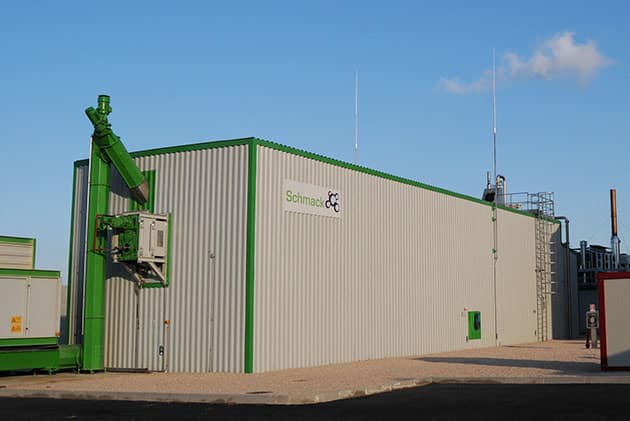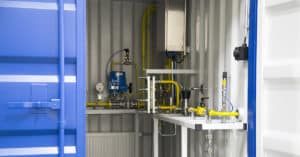
Biogas has been a hot topic for a few years now and many have questions and prejudices about it. We decided to gather here a few questions that we have heard over time and answer them to the best of our ability.
Since no list is complete and it may be that the question that concerns you is still unanswered, please send us a message – we will provide you with an answer.
“What happens to biogas if it leaks?”
Biogas is mainly a mixture of methane and carbon dioxide. Methane, lighter than air, rises into the atmosphere and carbon dioxide mixes with CO2 that is already in the air. Leakage is rarely dangerous, as methane needs a source of spark and an exact mixture with oxygen to ignite, but it causes greenhouse gas emissions and must therefore be sought and blocked.
“What’s the difference between biogas and biomethane?”
Biogas means a gas mixture produced in a biogas plant. In biogas, the methane content usually varies between 50-70 %, while the rest of the gas mixture contains carbon dioxide as well as small amounts of water, nitrogen, oxygen and some impurities. Biomethane refers to biogas from which most of the non-methane gases have been removed. Such a gas typically has a methane content of 95-99 %, with the remainder being carbon dioxide and small amounts of other gases. For gas car owners, biomethane as a fuel is familiar, because the “biogas” that is sold at gas filling stations and refueled in cars is biomethane.
“Isn’t biogas explosive?”
The methane contained in biogas is a combustible gas, but when comparing methane with petrol and diesel, which are typically used as fuels, it has a relatively high ignition temperature. Methane has a self-ignition temperature above 600°C compared to 260°C for petrol and 210°C for diesel. In addition, for methane to burn, it requires a proper mixing ratio of about 5-15 % to air. Because of this, when used as vehicle fuel, in an accident situation biogas/CNG is the safest option out of these three fuels.
“Does a biogas plant always look the same?”
No, it does not. There are several types of biogas plants. The most common biogas plants are round so-called wet fermentation plants, often with a semicircular membrane gas holder above them suitable for gas storage. In addition, there are plug flow plants where the reactors are rectangular in shape and typically have a flat roof. The third type is dry fermentation plants, which can be either garage-like or silo reactor type.

Wet fermentation plant. © Schmack Biogas Srl 
Plug flow plant. © Schmack Biogas Srl 
Dry fermentation plant. © Schmack Biogas Srl
“Biogas production volumes are small and therefore insignificant!”
According to IEA Key World Energy Statistics, in 2018 1.33 EJ of biogas was produced worldwide. That means about 370 TWh of energy, which corresponds to Finland’s total energy consumption in 2017. In Finland, annual biogas production is about 1 TWh.
“What happens to bacteria in a biogas plant?”
In Finland, if the end product of a biogas plant, i.e. the digestate, is utilized commercially, the quality of it is regulated by the Fertilizer Product Act and supervised by the Finnish Food Authority. In all the EU countries, the law obliges the hygienization of the feedstock material used in the biogas plant. This must be done either by heating the feedstock to 70°C for one hour, or by validating an alternative method. Repeated validation tests show that the harmful bacteria in the end product, i.e. digestate, are dead and no salmonella is present.
“Can entire animals be digested?”
In principle, yes, but the biogas plant feedstock pre-treatment required in the EU countries is guided by the Animal by-products Regulation, which is supervised by the local Food Safety Authority or similar organization. According to the Animal by-products Regulation, Category 1 materials – such as entire cows – cannot be digested, while Category 2 materials – such as entire pigs – can be digested as long as the material is crushed and pressure sterilized during digestion process.
“In the Nordic region, it is not worth having a biogas plant at the farm, because it won’t be profitable.”
It is true that for small-scale farms, it is often challenging to turn a biogas plant investment into profit within a reasonable payback time. However, the greatest untapped potential lies in farmer clusters. This consortium of farms implies that grass and manure are brought to a centralized biogas plant, from where dry and liquid fertilizers as well as produced electricity, heat or vehicle fuel are returned to and utilized at the individual farms. This way having a biogas plant at the smaller farm often turns out to be profitable.
Hopefully you found the answers to your questions from this blog post, and biogas and its production became slightly more familiar to you. If you have any other questions left, then contact us now ‒ we will be happy to answer and make new informative material. We hope you’ve enjoyed the blog!
Make sure you’ll receive our next blog post delivered straight to your inbox
You might be also interested in these articles:
- Biomethane grid connection unit promotes the growth of fossil-free fuels

- Biogas project 101: Success and Challenges
